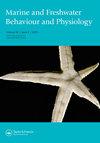父亲帮助释放三种弹涂鱼的幼虫
IF 1.1
4区 生物学
Q3 MARINE & FRESHWATER BIOLOGY
Marine and Freshwater Behaviour and Physiology
Pub Date : 2023-05-22
DOI:10.1080/10236244.2023.2211219
引用次数: 0
摘要
摘要在弹涂鱼中发现了空中胚胎孵化后,发现雄弹涂鱼通过抽去卵室的空气使卵浸入水中来诱导幼虫孵化。成虫是否会为新孵化的幼虫提供额外的支持,帮助它们离开洞穴内危及生命的缺氧水?本文比较了暗鳃弹涂鱼、皮尔斯弹涂鱼和细长弹涂鱼3种弹涂鱼的18个孵化事件。在抽气后,观察到3种不同的孔洞形状依赖于父本帮助幼虫离开孔洞的策略:(1)非常频繁地向孔洞轴或卵室潜水,产生有利于推动幼虫向水面移动的湍流;(2)尾巴的波动产生出一股水流,将孵化的幼虫带出洞穴;(3)将幼虫吸入父亲的口中,随后将其吐出来,将其驱逐出洞穴。本文章由计算机程序翻译,如有差异,请以英文原文为准。
Paternal help in larval release of three mudskipper species
Abstract After the discovery of aerial embryonic incubation in mudskippers, it was found that the male induces larval hatching by removing the air from the egg-chamber so that the eggs immerse in water. Do the adults provide additional support to the newly hatched larvae to help them leave the life-endangering hypoxic water inside the burrow? This paper compares 18 hatching events of 3 species: dusky gilled mudskipper, Pearse´s mudskipper and slender mudskipper. After air removal 3 different burrow-shape dependent strategies of paternal help for larval burrow leaving were observed: (1) very frequent diving toward the burrow shaft or into the egg-chamber to generate turbulences that can help to propel the larvae toward the water surface; (2) tail-undulation to create a water current out of the burrow that would take along the hatched larvae; and (3) intake of larvae into the paternal mouth, subsequently spitting them out to expel them from the burrow.
求助全文
通过发布文献求助,成功后即可免费获取论文全文。
去求助
来源期刊

Marine and Freshwater Behaviour and Physiology
生物-海洋与淡水生物学
CiteScore
2.10
自引率
0.00%
发文量
9
审稿时长
>12 weeks
期刊介绍:
Marine and Freshwater Behaviour and Physiology is devoted to the publication of papers covering field and laboratory research into all aspects of the behaviour and physiology of all marine and freshwater animals within the contexts of ecology, evolution and conservation.
As the living resources of the world’s oceans, rivers and lakes are attracting increasing attention as food sources for humans and for their role in global ecology, the journal will also publish the results of research in the areas of fisheries biology and technology where the behaviour and physiology described have clear links to the contexts mentioned above.
The journal will accept for publication Research Articles, Reviews, Rapid Communications and Technical Notes (see Instructions for authors for details). In addition, Editorials, Opinions and Book Reviews (invited and suggested) will also occasionally be published. Suggestions to the Editor-In-Chief for Special Issues are encouraged and will be considered on an ad hoc basis.
With the goal of supporting early career researchers, the journal particularly invites submissions from graduate students and post-doctoral researchers. In addition to recognising the time constraints and logistical limitations their research often faces, and their particular need for a prompt review process, accepted articles by such researchers will be given prominence within the journal (see Instructions for authors for details).
 求助内容:
求助内容: 应助结果提醒方式:
应助结果提醒方式:


